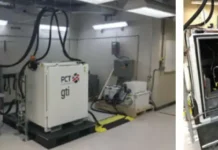By Im Rangwalla, Market Development Manager, Energy Sciences, Inc.
Yes.
Radiation-induced in situ polymerization reactions offer significant advantages over conventional thermal processes. The biggest advantage is the use of 100 percent reactive and compliant chemistry so no thermal drying is required.
Since the introduction of electron beam curing in the early ’60s, polymer chemists have been intrigued by the ability of the electrons to initiate polymerization reactions and cross-link plastic films without adding any photoinitiators, photosensitizers or peroxides. Immediate applications were sought in packaging using the free-radical-initiated chemistries, since electron beam processing offers high-speed curing. In particular, food packaging was of interest because electron beam processing results in the following:
- a high degree of conversion (low migration);
- packaging in which no photoinitators or other additives, such as peroxides, are required; and
- quality control that meets National Institute of Standards and Technology (NIST) traceable dosimetry techniques.
Applications for electron beam processing include curing of coatings, inks, pressure-sensitive and laminating adhesives, and cross-linking of films. For each of these applications, the development cycle begins at the chemistry supplier laboratory. Then the application goes through standard development in pilot phase, pre-commercial and then commercial. In each case, a different electron beam unit is used. Questions arise as to how to relate the established dose in the lab through various phases of development and then into ongoing production – especially after any maintenance on the EB unit. The answer is dosimetry.
A dosimeter can be anything that undergoes an observable and consistent physical change that can be correlated with the dose of radiation it has received. For example, some dosimeters change color when irradiated. This color change is due to the presence of a radiochromic dye that is blended in a polyamide matrix. The polyamide film then is cast out of solution, cut to a 1 x 1 cm2 area – called a radiochromic film dosimeter – and used to measure the output of electron beam accelerators. These dosimeters are either about 50 grams/m2 (used to measure dose from > 150 kV EB processors) or about 10 grams/m2 (used to measure dose of < 125 kV EB units).
These nylon films start off as clear, transparent films that change to a dark blue color after irradiation. The dose they receive can be correlated to change in optical density, which is measured by a densitometer or a spectrophotometer at a light of a specific wavelength, usually at 510 nm or 600 nm, depending on the type of dosimeter used. The measured change in optical density is correlated to dose by appropriate calibration to international standards. NIST is used in the US, and National Physics Laboratory (NPL) is used in Europe. These international standards facilities irradiate the dosimeters at pre-determined doses, using Co60 gamma rays to make the calibration curve specific to that dosimeter and reading instrument.
Electron beam processors using these dosimeters are characterized to measure three aspects of the EB unit.
1. Yield measurements: The EB processor has no direct knowledge of the dose being delivered to the product. It can, however, regulate the electron current density (beam current) proportional to the line speed to maintain a constant desired dose. This proportionality constant is measured with dosimetry and then programmed into the microprocessor of the EB unit. This constant “k” is specific to that particular EB unit and is dependent on the operating high voltage. The equation governing this relationship is as follows:

 Dose (D) is in Mrads or kGy
Dose (D) is in Mrads or kGy
Speed (S) is in FPM or MPM
Beam current (I) is in mA
K is Mrad.FPM/mA or kGy.MPM/mA
2. Beam uniformity: These dosimeters are spaced every one inch across the width of the EB unit to ensure uniform electron distribution across the width. Figure 1 is a typical uniformity of a 48-inch EB unit. Typical uniformity is < +/-10%.
 3. Depth dose: Dosimeters stacked on top of each other are used to measure the high-voltage calibration of the EB unit, which determines the electrons penetration capability. Figure 2 shows the depth-dose profiles from 70 to 125 kV. The measured values are compared with expected profiles to ensure the EB unit is in high-voltage calibration.
3. Depth dose: Dosimeters stacked on top of each other are used to measure the high-voltage calibration of the EB unit, which determines the electrons penetration capability. Figure 2 shows the depth-dose profiles from 70 to 125 kV. The measured values are compared with expected profiles to ensure the EB unit is in high-voltage calibration.






